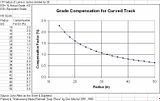Benchwork and roadbed
Another take on Spline Roadbed
Been laying Masonite Spline roadbed over the weekend and have about 30 feet completed. I used both 3/16 and 1/4" masonite riped to 1 1/2" thick.
Took about 30 min to rip up three sheets of masonite, nice to have all of the dust out of the RR room.
Used lots of glue, I am making splines about 2" wide for On30.
I love the way the spline makes natural curves.
Masonite Spline Roadbed - questions
Planning the construction of our layout and looking at Joe's DVD's and Charlies How-To's for building spline roadbed and the benchwork to support it.
In one area I'll just use a sheet of plywood for the roadbed instead of splines because of the number of tracks in the vicinity. Is the plywood going to be a lot noisier than the spline roadbed? It seems like it would be...?
Where I have two tracks running parallel and at the same grade should I use a separate spline for each track or should I make a wide spline to put two tracks on?
To cork or not to cork
I am about to lay track. The subroadbed is all in place and is plywood spline. The track is Peco streamline turnouts and flextrack.
I have Joe's DVDs and he uses latex caulk to glue the track straight onto the spline. Others on this forum and elsewhere use latex caulk to glue cork roadbed to their spline and then latex caulk to glue the track to the cork. There are other methods and materials as well.
Useage of Homasote (advanced techniques?)
I am looking for experience with the use of homasote. Has anyone used a router to create roadbed elevation? I currently have hand laid track on homosote. I would like to create a beveled edge to look like the track is elevated that is without removing the track. In fact I would like to use the track as the router guide by creating a fixture to attach on the router. Maybe there are others who have thought about this similarly and or even given it a try. Before I get started. I
Choices for subroadbed
First post here, love the site so far.
Here is where I am.
Got benchwork of 2x4" and 2x6", I know it's overkill, but that's what I had on hand. This is topped with 3/4" MDF, I can walk around this thing with no problem.
A good percentage of the edge will be a shoreline so I would like to have some height from the waterline to the roadbed.
My options as I see it.
Light-weight alternatives to extruded foam
I'm in the process of thinking about starting benchwork for a model railroad. I'm designing the benchwork with portability in mind (apartment dweller currently). My first pass through benchwork design leads is a simple box model: dimensional lumber framing the edges, with some lumber serving as bracing in the middle for a solid surface top. Since my layout will be on a single elevation, having a solid surface top seems to be the simplest solution.
Lighting Update From Home Depot
Checked with Home Depot today for a price on the Leviton porcelain light fixtures mentioned in Joe's Video #2. Had a bit of a shock. In the video, Joe says they can be purchased at Home Depot for "around $3.00". Not any more. According to their website, they now cost between $13 and $14 dollars. I'll opt for the plastic ones at $1.56. I guess that's progress!!!
Doug
A Couple of Questions
I have a couple of questions concerning roadbed construction. I plan to use masonite spline for the mainline trackage and plywood for larger yards. I want to use cork in the yards. Is it common practice to also use cork on the spline roadbed ? If not, what would be the best method to transition from the main to the yard trackage?
Super elevating curves on a branch line
Greetings all,
My new layout is a branch line off the Main line of the PRR in 1940 -50. There is a build thread over on Joe Fugate's Siskiyou Line forum. The branch is in a PA valley with access down the mountain and by the valley floor. This branch is serviced by the PRR. I cannot imagine that any of these trains will run at full speed as they would on the Main.
>> Posts index
Navigation
Journals/Blogs
Recent Blog posts:
